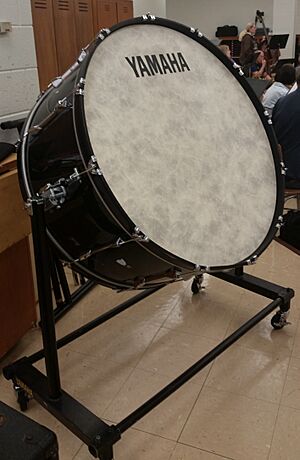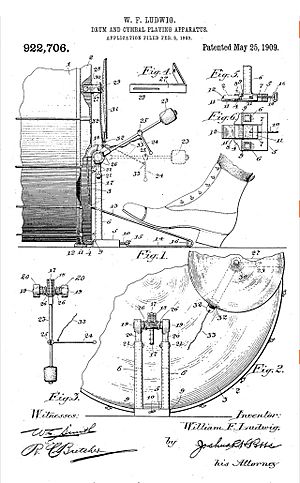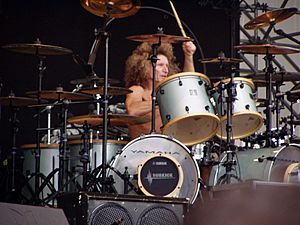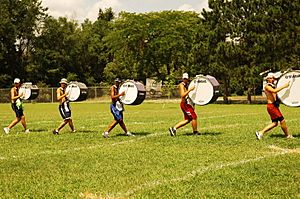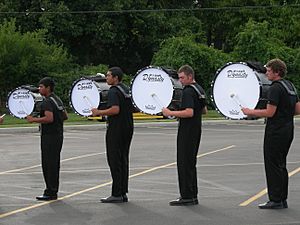Bass drum facts for kids

An orchestral bass drum
|
|
| Percussion instrument | |
|---|---|
| Classification | Percussion |
| Hornbostel–Sachs classification | 211.212.1 (Individual double-skin cylindrical drums) |
| Developed | Turkey |
The bass drum is a really big drum that makes a deep, low sound. Sometimes it has a clear musical note, and sometimes it just makes a deep thud. This drum is usually shaped like a cylinder, much wider than it is deep. It has a drumhead on both ends that you hit. These heads can be made from animal skin or plastic. You can also tighten them to change the sound.
Bass drums come in many sizes, but their size doesn't always mean they'll be louder. Different sizes can change the sound and pitch a lot. People also choose sizes for how easy they are to use or how they look. Bass drums are percussion instruments, meaning you hit them to make sound. They are used in many types of music.
There are three main kinds of bass drums:
- The orchestral bass drum is the biggest drum in an orchestra. You'll see it in concert bands and orchestras. In Italian, it's called gran cassa.
- The kick drum is a smaller bass drum used in a drum kit. You hit it with a special pedal that has a beater attached.
- The pitched bass drum is used in marching bands and drum corps. These drums are tuned to specific notes. They are often played in sets of three to six drums.
In many types of music, the bass drum helps keep the beat or mark time. When the mallet hits the drumhead, it makes a low "boom" sound. In marches, it helps set the speed for marching. In rock music, the bass drum often plays on the first and third beats of a measure. The snare drum plays on the second and fourth beats. In jazz, the bass drum can keep time or even play melodies with other parts of the drum set.
Contents
What's in a Name?
The bass drum has many names around the world. For example, it's called gran cassa in Italian. In French, it's grosse caisse, and in German, it's Grosse Trommel or Basstrommel. In Spanish, it's known as bombo.
A Look Back: History of the Bass Drum
The earliest drum similar to the bass drum was the Turkish davul. This drum was cylindrical and had two thin heads. These heads were stretched over hoops and attached to a narrow body. To play it, you'd hit the right side with a large wooden stick and the left side with a rod.
When hit, the davul made a much deeper sound than other drums back then. Because of its unique deep sound, davuls were used a lot in wars. Their loud, deep beat helped soldiers march together. In the 18th century, the military bands of the Ottoman Janissaries were among the first to use davuls. Their marching songs often had a strong beat from davuls, cymbals, and kettle drums.
Davuls were great for military use because they were easy to carry. Ottoman Janissaries hung their davuls on their chests with thick straps. This made it simple for soldiers to carry them during battles. This way of carrying drums wasn't just in the Ottoman Empire. In Egypt, similar drums were braced with cords, allowing soldiers to carry them while moving.
Davuls were also used in non-military music. For example, they were a big part of Turkish folk dances. In Ottoman society, davul and shawm (a type of wind instrument) players would perform together. These groups were called davul-zurnas, or drum and shawm circles.
Long Drums: Bigger and Deeper
The Ottoman Empire was very large, reaching from Vienna to North Africa and the Middle East. This helped spread Ottoman culture, including the davul, to other parts of the world. In Africa, people took the idea of the davul – a two-headed drum that makes a deep sound – and made it even bigger. They also changed the materials, leading to the long drum.
Long drums are usually made from a hollowed-out tree trunk. This is different from the davul, which has a thick shell. Long drums were typically about 2 meters (6.5 feet) long and 50 centimeters (20 inches) wide. This made them much larger than the Turkish drums they were based on. People also believed the tree used for the long drum had to be perfect. After making the basic frame, they would soak cow hides in boiling water to stretch them for the drumheads.
Like davuls, long drums were played with two different sticks on each side. However, long drums were mainly used for religious ceremonies, unlike davuls.
Gong Drums: A Different Sound
As long drums spread across Europe, musicians wanted even deeper sounds for their music. So, in the 1800s, a drum called the gong drum was introduced in Britain. This drum had a narrow shell and only one head. It was similar in size and how it was built to the long drum, being 70-100 centimeters (27-39 inches) wide.
When hit, the gong drum made a deep sound with a rich echo. But because it was so big and only had one head, it often made a sound with a specific musical note. This made it hard for composers to use in an orchestra, so it became less popular.
Modern Bass Drums: Orchestral and Drum Kit
Since gong drums weren't good for orchestras, musicians started making smaller versions that didn't have a specific pitch. This smaller drum is what we now call the orchestral bass drum. It's the type most people know today. Modern orchestral bass drums are mainly used in orchestras. Like the davul and long drum, they have two heads and are tightened with rods. They are usually about 40 inches (100 cm) wide and 20 inches (50 cm) deep. Most orchestral bass drums sit in a frame, so they can be tilted to any angle.
Bass drums are also a very important part of modern drum kits. In 1909, William Ludwig invented a working bass drum pedal. This pedal could hit a two-headed bass drum much like a drumstick. In the 1960s, many rock drummers, like Keith Moon from The Who and Ginger Baker from Cream, started using more than one bass drum in their drum kits.
Bass Drums in Classical Music
In classical music, composers have a lot of freedom with how they use the bass drum. Here are some common ways:
- Adding special "color" or mood to the music.
- Making big, single hits for dramatic moments.
- Playing long, rumbling rolls.
- Making loud parts of the music sound even stronger.
Besides the usual mallets, musicians might use mallets for other instruments, like keyboard percussion mallets or timpani mallets. Sometimes, they even use their hands or fingers. Techniques include rolls, quick repeated notes, and hitting the drum at the same time as other instruments. Bass drums can also be used for sound effects, like thunder or an earthquake.
How They Are Held
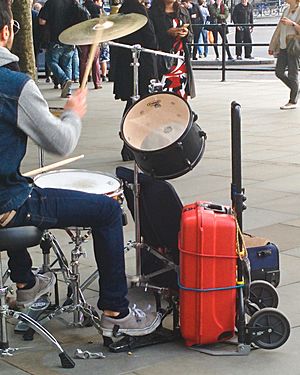
Bass drums are too big to hold by hand, so they are always mounted. Here are common ways they are held:
- Using a shoulder harness, so the drumheads face up and down.
- On a floor stand, as part of a drum kit. The drumheads are always vertical this way.
- On an adjustable stand. Here, the drumheads can be tilted from vertical to flat.
- Sometimes, a single cymbal can be attached to the bass drum.
What Hits the Drum?
Bass drums can be hit with different tools, depending on the music:
- A single heavy mallet covered in felt.
- If the drum is upright, one hand might hold the felt mallet, and the other might hold a rute (a bundle of thin sticks).
- For drum rolls, two matching bass drum mallets or a mallet with two heads are used.
- In a drum kit, a special mallet is attached to a pedal and is called a beater.
Bass Drums in Drum Kits
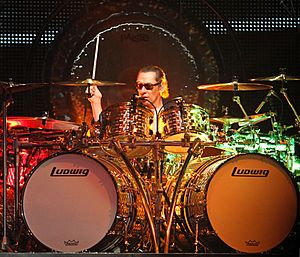
In a drum kit, the bass drum is much smaller than an orchestral one. It's usually about 20 or 22 inches (51 or 56 cm) wide. Sizes can range from 16 to 28 inches (41 to 71 cm) wide, and 12 to 22 inches (30 to 56 cm) deep. Older bass drums were often shallower than today's common 22x18 inch (56x46 cm) size.
Sometimes, the front drumhead of a kit bass drum has a hole. This lets air escape when the drum is hit, making the sound shorter. You can also put muffling materials through the hole without taking off the head. The hole also allows microphones to be placed inside for recording or making the sound louder. Many professional drummers like to have their band's logo or name on their bass drum's front head.
Kit bass drums are often muffled more than classical ones. Drummers might put a pillow, blanket, or special mufflers inside the drum. This rests against the hitting side to soften the sound and make a shorter "thud."
Different beaters make different sounds. Felt, wood, and plastic beaters are all popular. Bass drums sometimes have a mount on top for a tom-tom drum. This saves space and the need for another stand. Adding this mount means cutting a hole in the drum. Bass drums without this hole are called "virgin" bass drums and are often valued by drummers.
The Bass Drum Pedal
In 1900, the Sonor drum company made its first single bass drum pedal. Then, in 1909, William F. Ludwig made the bass drum pedal work really well. This was a huge step for the modern drum kit.
A bass drum pedal works a lot like a hi-hat pedal. You press down on a footplate. This pulls a chain, belt, or metal rod downwards, which swings a beater forward to hit the drumhead. The beater's head is usually made of felt, wood, plastic, or rubber. It's attached to a metal shaft. The pedal and beater are set in a metal frame. Like the hi-hat, a tension spring controls how much pressure is needed to hit the drum and how quickly the beater springs back.
Double Bass Drum Pedal
A double bass drum pedal works like a single one, but it has a second footplate. This second footplate controls another beater that hits the same drum. Usually, this second beater is connected by a shaft to the main pedal. One special type is the Sleishman twin pedal, which is symmetrical.
Some drummers choose to use two separate bass drums, with one pedal for each. This gives a similar effect.
Drop-Clutch for Hi-Hat
When you use a double bass drum pedal, your left foot (if you're right-footed) usually moves from the hi-hat pedal to the second bass drum pedal. This would leave the hi-hat open. To keep the hi-hat closed even when your foot isn't on its pedal, drummers use a drop clutch.
How to Play the Pedal
There are three main ways to play single notes with one foot:
- Heel-down technique: Your heel stays on the pedal, and you make strokes using your ankle. This is good for quiet playing and quick, uneven rhythms.
- Heel-up technique: Your heel is lifted off the pedal, and the strokes come from your hip. Your ankle still moves, but you can use your whole leg's weight for more power and louder sounds. Lifting your heel also lets you play double strokes.
- Floating stroke: Your heel is lifted like in heel-up, but the stroke mainly comes from your ankle, like in heel-down. This can allow for greater speed and more notes at louder volumes. However, it's not as good for slow or simple rhythms.
Drummers like Thomas Lang and Virgil Donati can play very complex solos while keeping a steady bass drum pattern. Thomas Lang, for example, is very good at both heel-up and heel-down techniques. He can play different rudiments (basic drum patterns) with his feet.
To play "doubles" (two quick notes) on the pedal, drummers use three main techniques: slide, swivel, or heel-toe.
- In the slide technique, you hit the middle of the pedal with the ball of your foot. As the drum sounds, you slide your toe up the pedal. The pedal naturally bounces back, hits your sliding toe, and rebounds for a second hit.
- In the swivel double, you hit the pedal once for the first note. Then, you quickly rotate your heel around the ball of your foot to the side of the pedal, playing a second stroke at the same time.
- In the heel-toe technique, your foot is held above the pedal. You bring your whole foot down, and the ball of your foot hits the pedal. Then, your foot snaps up, your heel lifts, and your toes come down for a second stroke.
Once mastered, these techniques let drummers play very fast double strokes on the bass drum. Famous players include Rod Morgenstein and Derek Roddy. These techniques are often used in death metal and other extreme music styles, where triggers and double bass drums are common. Some very fast tempos can only be played using double strokes.
Double Bass Drumming
In many types of heavy metal and hard rock, as well as some jazz and punk music, drummers use two bass drums. Or, they might use two pedals on one bass drum. Using two drums can look impressive on big stages. Sometimes, the second drum is tuned differently to add more variety to the sound.
The first person to use and make double bass drums popular was jazz drummer Louie Bellson. He thought of the idea when he was in high school. Double bass drums became popular in the 1960s with rock drummers like Ginger Baker (Cream), Mitch Mitchell (Jimi Hendrix Experience), Keith Moon (The Who), and Nick Mason (Pink Floyd).
After 1970, drummers like Billy Cobham and Narada Michael Walden used double kick drums in jazz fusion. Chester Thompson used them with Frank Zappa, and Barriemore Barlow with Jethro Tull. For these music styles, the focus was on complex rhythms and amazing solos. Double bass drumming later became a key part of heavy metal music. Pioneers included Les Binks, Carmine Appice, Ian Paice, and Cozy Powell. Slayer's former drummer Dave Lombardo was even called "the godfather of double bass." Later metal styles, like death metal, use double kick drumming a lot, often with very fast blast beat techniques. They focus on being super precise, having great endurance, speed, and quick footwork.
Double bass drumming can be done with different techniques. Most commonly, it's simple alternating single strokes. But to play faster, some drummers use the heel-toe technique. This allows them to make two hits with one foot movement, which causes less tiredness at higher speeds.
Many drummers have pushed the limits of double bass drumming. These include Terry Bozzio, Simon Philips, Virgil Donati, Derek Roddy, and Gene Hoglan. Bozzio introduced the idea of playing steady patterns (ostinatos) with his feet while playing freely with his hands, creating complex rhythms. Donati is known for using inverted double strokes with both feet. Roddy, Hoglan, and George Kollias are known as leaders in extreme metal drumming, playing single strokes at very high speeds.
If you want to learn more about double bass drumming, there are books like Encyclopedia of Double Bass Drumming by Bobby Rondinelli and Michael Lauren. Other helpful books include Double Bass Drumming by Joe Franco and Double Bass Drum Freedom by Virgil Donati.
Bass Drums in Marching Bands
In marching bands and drum and bugle corps, the "bass line" is a special group of marching bass drums. Each drum is tuned to a different note. This gives the bass line a unique role in the music. Skilled bass lines play complex musical parts that are split among the drums. This adds a melodic (tune-like) element to the percussion section.
The marching bass drum's main purpose is to play complex rhythms and melodies, not just to keep the beat. The bass line adds impact, melody, and helps keep the tempo. A bass line usually has three to five musicians, but can have as few as two or as many as seven. Most high school drumlines have three to five bass drums.
Parts of a Bass Line
A bass line usually has four or five musicians, each carrying one tuned bass drum. Smaller groups might have fewer. Some groups have even had one musician play more than one bass drum, usually smaller ones stacked on top of each other.
The drums are typically between 16 and 32 inches (41 and 81 cm) wide. Some groups use drums as small as 14 inches (36 cm) or larger than 36 inches (91 cm). The drums in a bass line are tuned so that the largest drum plays the lowest note. The pitch gets higher as the drum size gets smaller. Each drum is usually tuned higher than other bass drums of the same size. This helps complex rhythms be heard clearly.
Unlike other drums in a drumline, bass drums are usually carried sideways. The drumhead faces horizontally, not vertically. This means bass drummers must face sideways to the audience. They are often the only section in a band whose bodies don't face the audience while playing. Bass drummers usually point their drums at the back of the person in front of them. This lines up all the drumheads for the audience, making the best sound.
How They Play
Since the bass drum is held differently, the way you hit it is also different. But the basic ideas are the same. The player's forearms should be parallel to the ground, bent at the elbows. The arm from shoulder to elbow should be straight up. The mallet should be held pointing up at a 45-degree angle. The hands hold the mallets so the center of the mallet hits the center of the drumhead. The bottom of the mallet shaft should be against the bottom part of the hand.
The basic stroke motion is like turning a doorknob (forearm rotation) or like a snare drummer's wrist movement. Often, it's a mix of both. Bass drum techniques vary a lot between groups. Some techniques also use the fingers to help move the mallet.
A single hit makes one sound, but a bass line can make many sounds. The "unison" is very common. This is when all the bass drums play a note at the same time, with a balanced sound. This creates a very full, powerful sound. A "rim click" is when the mallet shaft hits the rim of the drum. This can be done alone or by everyone at once. Rimshots (hitting the rim and head at the same time) are rare on bass drums and usually only happen on the smaller, higher-pitched drums.
Each position in a typical five-person bass line needs different skills. The idea that "higher is better" is not true; each drum has a very important role.
- Bottom (or fifth) bass is the largest, heaviest, and lowest drum. It often helps keep the steady beat for the whole group. It's sometimes called the "heartbeat" of the group. This player might not play as many fast notes as others, but their role is key to the sound of the bass line and the whole band.
- Fourth bass is a bit smaller than the bottom drum. It can sound similar but usually plays slightly faster parts. It's more likely to play "off the beat" (in the middle of a musical phrase, not at the beginning or end).
- Third bass is the middle drum in both size and sound. It plays a key role in making complex musical parts clear.
- Second bass often plays notes that are right next to the beginning or end of a musical phrase, rather than on the main beat. This can be tricky for new players. Sometimes this drum works like the top drum, but usually the second and top drummers work together to play difficult parts split between them.
- Top (or first) bass is the highest-pitched drum. It usually starts or ends musical phrases. Its drumheads are very tight, allowing this player to play notes as challenging as those on the snare drum. Often, the top bass will play in unison with the snare line to add depth to their sound.
Some bass lines have more than five bass drums. The largest drum is given the highest number (e.g., bass 7 in a 7-drum line), and the smallest is still called first bass.
Marching with Bass Drums
In a marching band's field show, bass drummers usually face sideways. It can be hard to see the drum major (the band leader) and other players when facing away from the center of the field. So, players might turn to face the opposite direction during a show. These turns are usually done all at once or in a wave for a different effect.
With very large bass drums, it takes more strength and control to turn quickly. To make a clean turn, the player needs to use their strong core muscles to stop the drum's movement at the right time and direction.
In some marching bands, the bass drum is used to give orders to the band:
- One hit means the band (and troops) should start or stop marching.
- Two hits mean the band should stop marching.
- Two strong hits (a "Double Beat") are used when the music is about to end.
See also
 In Spanish: Bombo para niños
In Spanish: Bombo para niños


